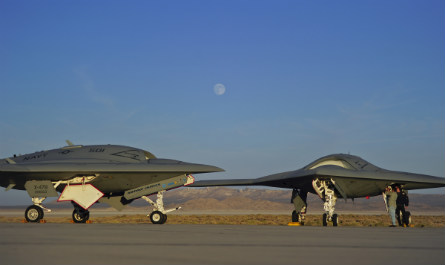The US Navy is set to approve the unmanned carrier launched surveillance and strike (UCLASS) aircraft as a formal acquisition programme later this year, but has yet to decide the scope of what the type's limited operational capability - set for 2020 - will constitute.
"The contract award date will be [identified] in the approved strategy in support of a 2012 Milestone A decision," says navy UCLASS programme manager Charlie Nava in a written statement to Flightglobal. This status would signify that a new procurement programme has been formally approved.
The USN will issue a request for proposals (RfP) only after the service and the US Department of Defense have fully examined the data gathered from a previously issued request of information and broad agency announcement studies. The information collected is already proving to be useful, Nava says.
"The date is still [to] be determined," he says of a potential RfP. "The overarching acquisition strategy for UCLASS is being vetted through the Department of [the] Navy and Office of the Secretary of Defense."
On 24 February, the navy announced it would seek further broad agency studies, having awarded four such studies last June. According to the navy, these will help to develop new operating concepts, system architectures, requirements documents and examine new "potential material solutions" to meet its operational needs.
In previous years, the USN emphasised getting the unmanned reconnaissance and strike aircraft into service as soon as possible, with an initial operational capability date set for 2018. However, with the roll-out of President Barack Obama's fiscal year [FY] 2013 budget request, the service says "limited operational capability" will be pushed back to FY2020.
The delay was not unexpected, says analyst Dan Goure of the Lexington Institute in Virginia. "That wasn't surprising, really," he says. The navy still has not clearly articulated what the aircraft's role will be and the technology is still very immature, Goure adds.
The navy says it needs a carrier-based unmanned air system to provide persistent intelligence, surveillance and reconnaissance (ISR) and precision strike capabilities.
 |
|---|
© Northrop Grumman |
Much of the technology needed for the UCLASS is being developed and tested under the auspices of the navy's X-47B unmanned combat air system demonstration (UCAS-D) effort being performed by Northrop Grumman. The service hopes that the UCLASS will be an operational follow-on to the X-47B.
"The ongoing UCAS-D programme is an essential early step that will demonstrate the suitability of unmanned air systems operating in the [carrier] environment, but contains no operational mission systems," Nava says. "UCLASS will be the navy's first carrier-based operational unmanned air system capable of integrating with manned platforms as part of the Carrier Air Wing."
Technology from the X-47B, including government-owned hardware, software and aircraft-ship interfaces, will also be harvested for the UCLASS effort, Nava says.
According to the solicitation for additional broad agency announcement studies last month, an operational system would consist of an air segment, which includes the air vehicle, ISR hardware and remote vehicle control system. But the UCLASS would also include a control system and connectivity segment that would be able to link to other US military assets and a carrier segment for shipboard interfaces, shipboard facilities and aircraft launch/recovery apparatus.
While it might be possible to bring the aircraft into "limited" service by 2020, it is not clear what the navy means by limited operational capability, Goure says.
The navy does not disagree, having yet to fully flesh out what it hopes to accomplish.
"Based upon the ongoing analysis, the navy has recently identified 2020 as the operational assessment timeframe," Nava says. Right now, it is using the terms "operational assessment" and "limited operational capability" interchangeably, he adds.
The challenge will be to build an aircraft that can not only operate routinely from the deck of a carrier at sea, but also conduct some sort of useful mission once it is in the air, Goure says.
Given the state of the technology and current budgetary climate, entering into an operational assessment phase by 2020 might be a more reasonable objective, Goure says.
"An operational assessment is much more limited than an initial operating capability," he says. "That would make more sense."
Industry officials say the navy's plans are too nebulous for them to comment in any meaningful way.
The USN has asked for just over $122 million in the FY2013 budget proposal to fund the UCLASS programme.
If there are no further defence cuts, the navy might have a chance of funding the programme to fruition, Goure says. But if US defence outlays are seriously curtailed because of the so-called budget sequestration measure in Congress, he believes the UCLASS programme is all but doomed.
Source: Flight International























